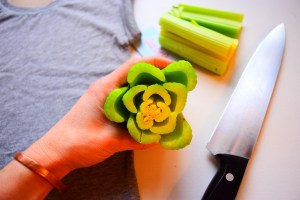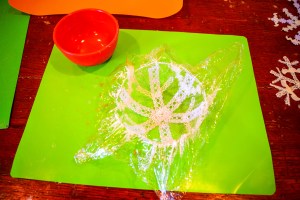“The Christmas Tree Teepee” is quirky, fun, and magical…perfect for celebrating Christmas with kids! So often when building forts for the kids, they beg me to get inside to play with them and I just barely fit, if at all. This teepee is big! It’s nearly 6 feet across and 7 feet tall, leaving plenty of room for 3-4 people inside, adults included! It’s perfect! So far this week, in our teepee, we’ve eaten breakfast every morning, made christmas garlands and decorations to send loved ones, played board games and puzzles, and each night before bed we curl up and read a couple Christmas books under the lights. We just love it! After the holidays I plan to collapse the teepee, folding it up much like an umbrella, wrap it in plastic and stow it away. Next year we plan to set the teepee up in L’s bedroom during December and let both girls sleep inside!

Since the teepee is replacing our tree this year it includes all the trimmings…sparkly lights, colorful ornaments, and a few surprises when you get inside and look close! The best place to find fabric for this project is at a local, second-hand store or an antique/junk store. We have an awesome antique store in the area that has a booth full of fabrics. Most of the fabric is clearly from the 80s and 90s (ie. funky and fun!) and is anywhere from $1 -$6 per piece. I picked out anything green with various patterns and textures: corduroy, twill, jersey-knit, silk, suede. You really can’t beat the prices for all that material! I was also lucky enough to stumble upon a bunch of, what I call, “old-lady, sequined, Christmas appliqués” in the same booth. They were all less than a dollar a piece and made for perfect ornaments for the “Christmas Tree Teepee.”

Oh, and did I mention that there’s NO SEWING INVOLVED when making this teepee??? I do not, cannot sew, especially anything of this magnitude! It’s held together all thanks to my handy, dandy hot glue gun. We had so much fun with this project!

Materials needed:
- 6 x 1″x 2″x 8′ lumber (Any quality will do, but I went for the nicer, less splinter-filled sort!)
- jute
- green fabrics
- christmas lights
- felt or sequined Christmas appliqués
- drill
- hot glue gun and glue
- scissors
First, drill two holes in each wooden, teepee pole. One 12″-15″ from the top, and the other 1″ from the bottom.


String some jute through the holes that are 12″ from the top, before carrying it all inside. Having someone help you, spread your teepee poles out and around until you get the teepee shape you’re looking for. (It will not be perfect, so don’t drive yourself crazy trying to make it perfect! Just go with it!) Once the poles are in place, wrap the jute around and in-between the poles until they are secured.


To ensure that the poles won’t move on you too much, thread some jute around the bottom too, knotting it around each pole. Even though the poles can move closer together and shift a little bit, it certainly helps to see where they originally were and where you want them to be while building your teepee.


Now for the real work. You will cut strips of fabric and using the hot glue gun, secure them in place along the teepee poles. First, spread out all your fabrics and see which material you have the most of. You will need to use this for the bottom. I didn’t use a ruler or yardstick to measure my fabric precisely while working, instead I laid it out on our hardwood floor, and just used the planks of wood to “measure” each strip of fabric.

Looking at the teepee, you may think I used one long piece of fabric to wrap around the entire structure, but in fact, each layer is made up of 5 shorter strips running from pole to pole. I started each layer with one piece of fabric along the outside of teepee…wrapping, gluing, trimming, and tucking the fabric into place. Now this is just the first section, between the first two poles. On the next section, I ran the fabric along the inside, gluing it into place. When done in this manner, the teepee poles will be invisible from the inside and outside of the teepee (except for the top of course) and all you will see is green, green, green! The pattern on each layer was outside-inside-outside-inside-outside. If you get frustrated at the beginning and things aren’t perfect, do not worry! After attaching the first few pieces, you will certainly know what you’re doing and the process will get a lot easier…promise!



As you go up the teepee, adding more layers, overlap the fabric by a couple inches above and below. This will help avoid gaps in the teepee. If there are places where gaps are seen, you can use a touch of hot glue to fasten the fabrics together.



As I got to the very top of the teepee, on the last two layers I used light-weighted fabrics that gathered well. Instead of cutting each sectioned-piece and gluing it outside-inside-outside, etc., I loosely gathered it around the teepee and glued it in place along the outside. I wanted the poles exposed on the inside in the top so I could string-up some Christmas lights to brighten things up a bit!

The top and front of the teepee was a bit of trial and error. I sort of knew how I wanted the finished teepee to look, so I wrapped fabric, held up fabric, and pinned some in place until I was satisfied. Here again, it was important that I saved my light-weighted fabrics that gathered well for the top and front of the teepee to achieve this look. I must say that it looks even better than I imagined…both like a teepee and a tree!


I was up in the air on whether to decorate the outside of the teepee, the inside or both. We decided on just the inside, keeping the magic inside and “secret” for all those who enter. L and I used duct tape to tape each sequined ornament in place. I could have glued them, but I wanted something that could be done by the children, year after year.


Inside the teepee, just below the lights, is my favorite little detail. I’ve held onto these fabric scraps of Santa flying through the night sky for a few years now, not sure what to do with them. Their placement, tucked away inside our teepee, is just the perfect home for them…I knew I was saving them for a reason!


The Christmas blanket underneath our teepee is the finishing touch. We usually use the blanket as a tree skirt around our tree each year, and in a way it is the tree skirt once again. This time it’s just in a more practical, more appreciated, and loved sort of way!


Think you’re ready to build your own??? Go for it! Your kids will absolutely love snuggling inside the Christmas tree this year, reading books, drinking hot chocolate, and playing games!
Feel free to leave any questions you may have below. Enjoy!!!





























































































































































